Development of Efficient and Recyclable ZnO–CuO/g–C3N4 Nanocomposite for Enhanced Adsorption of Arsenic from Wastewater
Abstract
1. Introduction
2. Experimental Section
2.1. Synthesis of ZnO–CuO Heterostructure
2.2. Synthesis of g–C3N4 and ZnO–CuO/g–C3N4 Composite
2.3. Batch Adsorption Experiments
3. Results and Discussions
3.1. XRD and FT-IR Analysis
3.2. HR-TEM Analysis
3.3. SEM and EDX Analysis
3.4. Nitrogen Adsorption-Desorption Study
XPS Examination
3.5. Batch Adsorption Experiment
3.6. Effect of Physical Parameters on the Adsorption of Arsenic
3.7. Adsorption Isotherms
3.8. Adsorption Kinetics
3.9. Statistical Analysis
3.9.1. Hypothesis Confirming Optimum pH of Adsorption of Arsenic (III)
3.9.2. Hypothesis to Confirm the Success of the Experiment Using ZnO–CuO/g–C3N4 as Adsorbent
3.10. Mechanism of As(III) Removal
4. Conclusions
Author Contributions
Funding
Conflicts of Interest
References
- Singh, R.; Singh, S.; Parihar, P.; Singh, V.P.; Prasad, S.M. Arsenic contamination, consequences and remediation techniques: A review. Ecotoxicol. Environ. Saf. 2015, 112, 247–270. [Google Scholar] [CrossRef] [PubMed]
- Rathi, B.S.; Kumar, P.S. A review on sources, identification and treatment strategies for the removal of toxic Arsenic from water system. J. Hazard. Mater. 2021, 418, 126299. [Google Scholar] [CrossRef]
- Jyothi, M.S.N.; Gayathri, S.; Gandhi, T.P.; Maliyekkal, S.M. Dissolved Arsenic in Groundwater Bodies: A Short Review of Remediation Technologies. In Pollution Control Technologies; Springer: Berlin/Heidelberg, Germany, 2021. [Google Scholar]
- Madhukar, M.; Murthy, B.M.S.; Udayashankara, T.H. Sources of Arsenic in Groundwater and its Health Significance-A Review. Nat. Environ. Pollut. Technol. 2016, 15, 971–979. [Google Scholar]
- Sarı, A.; Tuzen, M. Biosorption of As(III) and As(V) from aqueous solution by macrofungus (Inonotus hispidus) biomass: Equilibrium and kinetic studies. J. Hazard. Mater. 2009, 164, 1372–1378. [Google Scholar] [CrossRef] [PubMed]
- Shrivastava, A. Dietary Arsenic Exposure: Sources and Risks. In Arsenic Toxicity: Challenges and Solutions; Kumar, N., Ed.; Springer Singapore: Singapore, 2021; pp. 95–125. [Google Scholar]
- Fauser, P.; Sanderson, H.; Hedegaard, R.V.; Sloth, J.J.; Larsen, M.M.; Krongaard, T.; Bossi, R.; Larsen, J.B. Occurrence and sorption properties of arsenicals in marine sediments. Environ. Monit. Assess. 2013, 185, 4679–4691. [Google Scholar] [CrossRef] [PubMed]
- Ahmad, S.; Wang, S.; Wu, W.; Yang, K.; Zhang, Y.; Tumukunde, E.; Wang, S.; Wang, Y. Functional Analysis of Peptidyl-prolyl cis-trans Isomerase from Aspergillus flavus. Int. J. Mol. Sci. 2019, 20, 2206. [Google Scholar] [CrossRef]
- Giri, A.K.; Patel, R.K.; Mahapatra, S.S. Artificial neural network (ANN) approach for modelling of arsenic (III) biosorption from aqueous solution by living cells of Bacillus cereus biomass. Chem. Eng. J. 2011, 178, 15–25. [Google Scholar] [CrossRef]
- Wang, S.; Mulligan, C.N. Speciation and surface structure of inorganic arsenic in solid phases: A review. Environ. Int. 2008, 34, 867–879. [Google Scholar] [CrossRef]
- Wu, W.Z.; Ahmad, S.; Wang, S.; Zhang, Y.F.; Yang, H.; Wang, S.H.; Wang, Y. Expression and antibody preparation of Small Ubiquitin-like Modifier (SUMO) from Aspergillus flavus. In IOP Conference Series: Earth and Environmental Science; IOP Publishing: Bristol, UK, 2019; Volume 346, p. 012002. [Google Scholar]
- Gomez-Caminero, A.; Howe, P.D.; Hughes, M.; Kenyon, E.; Lewis, D.R.; Moore, M.; Aitio, A.; Becking, G.C.; Ng, J.; International Programme on Chemical; et al. Arsenic and Arsenic Compounds; WHO: Geneva, Switzerland, 2001. [Google Scholar]
- Monoj Kumar, M.; Garg, R. A comprehensive review on removal of arsenic using activated carbon prepared from easily available waste materials. Environ. Sci. Pollut. Res. 2017, 24, 13295–13306. [Google Scholar]
- Zaw, M.; Emett, M.T. Arsenic removal from water using advanced oxidation processes. Toxicol. Lett. 2002, 133, 113–118. [Google Scholar] [CrossRef]
- Nicomel, N.R.; Leus, K.; Folens, K.; Van Der Voort, P.; Du Laing, G. Technologies for Arsenic Removal from Water: Current Status and Future Perspectives. Int J. Env. Res. Public Health 2015, 13, 62. [Google Scholar] [CrossRef] [PubMed]
- Mohan, D.; Pittman, U., Jr. Arsenic removal from water/wastewater using adsorbents—A critical review. J. Hazard. Mater. 2007, 142, 1–53. [Google Scholar] [CrossRef] [PubMed]
- Kim, J.; Benjamin, M.M. Modeling a novel ion exchange process for arsenic and nitrate removal. Water Res. 2004, 38, 2053–2062. [Google Scholar] [CrossRef] [PubMed]
- Farrell, J.; Wang, J.; O'Day, P.; Conklin, M. Electrochemical and spectroscopic study of arsenate removal from water using zero-valent iron media. Environ. Sci. Technol. 2001, 35, 2026–2032. [Google Scholar] [CrossRef] [PubMed]
- Yamani, J.S.; Lounsbury, A.W.; Zimmerman, J.B. Towards a selective adsorbent for arsenate and selenite in the presence of phosphate: Assessment of adsorption efficiency, mechanism, and binary separation factors of the chitosan-copper complex. Water Res. 2016, 88, 889–896. [Google Scholar] [CrossRef]
- Yu, X.-Y.; Luo, T.; Jia, Y.; Zhang, Y.-X.; Liu, J.-H.; Huang, X.-J. Porous hierarchically micro-/nanostructured MgO: Morphology control and their excellent performance in As (III) and As (V) removal. J. Phys. Chem. C 2011, 115, 22242–22250. [Google Scholar] [CrossRef]
- Mou, F.; Guan, J.; Ma, H.; Xu, L.; Shi, W. Magnetic iron oxide chestnutlike hierarchical nanostructures: Preparation and their excellent arsenic removal capabilities. ACS Appl. Mater. Interfaces 2012, 4, 3987–3993. [Google Scholar] [CrossRef]
- Cao, C.-Y.; Qu, J.; Yan, W.-S.; Zhu, J.-F.; Wu, Z.-Y.; Song, W.-G. Low-cost synthesis of flowerlike α-Fe2O3 nanostructures for heavy metal ion removal: Adsorption property and mechanism. Langmuir 2012, 28, 4573–4579. [Google Scholar] [CrossRef]
- Guo, S.; Sun, W.; Yang, W.; Xu, Z.; Li, Q.; Shang, J.K. Synthesis of Mn3O4/CeO2 hybrid nanotubes and their spontaneous formation of a paper-like, free-standing membrane for the removal of arsenite from water. ACS Appl. Mater. Interfaces 2015, 7, 26291–26300. [Google Scholar] [CrossRef]
- Jeong, Y.; Fan, M.; Singh, S.; Chuang, C.-L.; Saha, B.; Van Leeuwen, J.H. Evaluation of iron oxide and aluminum oxide as potential arsenic (V) adsorbents. Chem. Eng. Processing-Process. Intensif. 2007, 46, 1030–1039. [Google Scholar] [CrossRef]
- Li, W.; Chen, D.; Xia, F.; Tan, J.Z.; Huang, P.-P.; Song, W.-G.; Nursam, N.M.; Caruso, R.A. Extremely high arsenic removal capacity for mesoporous aluminium magnesium oxide composites. Environ. Sci. Nano 2016, 3, 94–106. [Google Scholar] [CrossRef]
- Cao, A.-M.; Monnell, J.D.; Matranga, C.; Wu, J.-M.; Cao, L.-L.; Gao, D. Hierarchical nanostructured copper oxide and its application in arsenic removal. J. Phys. Chem. C 2007, 111, 18624–18628. [Google Scholar] [CrossRef]
- Saddam, A.; Wang, H.; Liu, Y.; Peng, J.; Jiang, H. Variable universe fuzzy logic-based hybrid LFC control with real-time implementation. IEEE Access 2019, 7, 25535–25546. [Google Scholar]
- Hristovski, K.; Baumgardner, A.; Westerhoff, P. Selecting metal oxide nanomaterials for arsenic removal in fixed bed columns: From nanopowders to aggregated nanoparticle media. J. Hazard. Mater. 2007, 147, 265–274. [Google Scholar] [CrossRef] [PubMed]
- Awual, M.R.; Yaita, T.; Suzuki, S.; Shiwaku, H. Ultimate selenium (IV) monitoring and removal from water using a new class of organic ligand based composite adsorbent. J. Hazard. Mater. 2015, 291, 111–119. [Google Scholar] [CrossRef]
- Awual, M.R.; El-Safty, S.A.; Jyo, A. Removal of trace arsenic (V) and phosphate from water by a highly selective ligand exchange adsorbent. J. Environ. Sci. 2011, 23, 1947–1954. [Google Scholar] [CrossRef]
- Awual, M.R.; Asiri, A.M.; Rahman, M.M.; Alharthi, N.H. Assessment of enhanced nitrite removal and monitoring using ligand modified stable conjugate materials. Chem. Eng. J. 2019, 363, 64–72. [Google Scholar] [CrossRef]
- Gupta, K.; Ghosh, U.C. Arsenic removal using hydrous nanostructure iron (III)–titanium (IV) binary mixed oxide from aqueous solution. J. Hazard. Mater. 2009, 161, 884–892. [Google Scholar] [CrossRef]
- Chen, B.; Zhu, Z.; Ma, J.; Qiu, Y.; Chen, J. Surfactant assisted Ce–Fe mixed oxide decorated multiwalled carbon nanotubes and their arsenic adsorption performance. J. Mater. Chem. A 2013, 1, 11355–11367. [Google Scholar] [CrossRef]
- Alka, S.; Shahir, S.; Ibrahim, N.; Ndejiko, M.J.; Vo, D.V.N.; Manan, F.A.J.J.o.C.P. Arsenic removal technologies and future trends: A mini review. J. Clean. Prod. 2021, 278, 123805. [Google Scholar] [CrossRef]
- Lata, S.; Samadder, S. Removal of arsenic from water using nano adsorbents and challenges: A review. J. Environ. Manag. 2016, 166, 387–406. [Google Scholar] [CrossRef] [PubMed]
- Huo, L.; Zeng, X.; Su, S.; Bai, L.; Wang, Y. Enhanced removal of As (V) from aqueous solution using modified hydrous ferric oxide nanoparticles. Sci. Rep. 2017, 7, 40765. [Google Scholar] [CrossRef] [PubMed]
- Awual, M.R.; Jyo, A. Rapid column-mode removal of arsenate from water by crosslinked poly (allylamine) resin. Water Res. 2009, 43, 1229–1236. [Google Scholar] [CrossRef] [PubMed]
- Barrio, J.; Mateo, D.; Albero, J.; García, H.; Shalom, M. A Heterogeneous Carbon Nitride–Nickel Photocatalyst for Efficient Low-Temperature CO2 Methanation. Adv. Energy Mater. 2019, 9, 1902738. [Google Scholar] [CrossRef]
- Barrio, J.; Volokh, M.; Shalom, M. Polymeric carbon nitrides and related metal-free materials for energy and environmental applications. J. Mater. Chem. A 2020, 8, 11075–11116. [Google Scholar] [CrossRef]
- Fu, J.; Yu, J.; Jiang, C.; Cheng, B. g-C3N4-Based Heterostructured Photocatalysts. Adv. Energy Mater. 2018, 8, 1701503. [Google Scholar] [CrossRef]
- Zhang, G.; Li, G.; Wang, X. Surface Modification of Carbon Nitride Polymers by Core–Shell Nickel/Nickel Oxide Cocatalysts for Hydrogen Evolution Photocatalysis. ChemCatChem 2015, 7, 2864–2870. [Google Scholar] [CrossRef]
- Chen, X.; Wu, Z.; Liu, D.; Gao, Z. Preparation of ZnO Photocatalyst for the Efficient and Rapid Photocatalytic Degradation of Azo Dyes. Nanoscale Res. Lett. 2017, 12, 143. [Google Scholar] [CrossRef]
- Bojdys, M.J.; Müller, J.O.; Antonietti, M.; Thomas, A.J.C.A.E.J. Ionothermal synthesis of crystalline, condensed, graphitic carbon nitride. Chem. A Eur. J. 2008, 14, 8177–8182. [Google Scholar] [CrossRef]
- Zhu, B.; Xia, P.; Ho, W.; Yu, J. Isoelectric point and adsorption activity of porous g-C3N4. Appl. Surf. Sci. 2015, 344, 188–195. [Google Scholar] [CrossRef]
- Javed, M.S.; Lei, H.; Wang, Z.; Liu, B.-T.; Cai, X.; Mai, W.J.N.E. 2D V2O5 nanosheets as a binder-free high-energy cathode for ultrafast aqueous and flexible Zn-ion batteries. Nano Energy 2020, 70, 104573. [Google Scholar] [CrossRef]
- Javed, M.S.; Lei, H.; Shah, H.U.; Asim, S.; Raza, R.; Mai, W. Achieving high rate and high energy density in an all-solid-state flexible asymmetric pseudocapacitor through the synergistic design of binder-free 3D ZnCo2O4 nano polyhedra and 2D layered Ti3C2Tx-MXenes. J. Mater. Chem. A 2019, 7, 24543–24556. [Google Scholar] [CrossRef]
- Mateen, A.; Javed, M.S.; Khan, S.; Saleem, A.; Majeed, M.K.; Khan, A.J.; Tahir, M.F.; Ahmad, M.A.; Assiri, M.A.; Peng, K.-Q. Metal-organic framework-derived walnut-like hierarchical Co-O-nanosheets as an advanced binder-free electrode material for flexible supercapacitor. J. Energy Storage 2022, 49, 104150. [Google Scholar] [CrossRef]
- Javed, M.S.; Shaheen, N.; Hussain, S.; Li, J.; Shah, S.S.A.; Abbas, Y.; Ahmad, M.A.; Raza, R.; Mai, W.J.J.o.m.c.A. An ultra-high energy density flexible asymmetric supercapacitor based on hierarchical fabric decorated with 2D bimetallic oxide nanosheets and MOF-derived porous carbon polyhedra. J. Mater. Chem. A 2019, 7, 946–957. [Google Scholar] [CrossRef]
- Ge, X.; Ma, Y.; Song, X.; Wang, G.; Zhang, H.; Zhang, Y.; Zhao, H. β-FeOOH Nanorods/Carbon Foam-Based Hierarchically Porous Monolith for Highly Effective Arsenic Removal. ACS Appl. Mater. Interfaces 2017, 9, 13480–13490. [Google Scholar] [CrossRef] [PubMed]
- Liu, Y.; Peng, Y.; Zhang, T.; Qiu, F.; Yuan, D. Superhydrophobic, ultralight and flexible biomass carbon aerogels derived from sisal fibers for highly efficient oil–water separation. Cellulose 2018, 25, 3067–3078. [Google Scholar] [CrossRef]
- Wang, Y.; Xu, J.; Xu, X.; Yang, D.; Zheng, X.; Pan, J.; Zhang, T.; Qiu, F.; Li, C. Mesoporous hollow silicon spheres modified with manganese ion sieve: Preparation and its application for adsorption of lithium and rubidium ions. Appl. Organomet. Chem. 2018, 32, e4182. [Google Scholar] [CrossRef]
- Babu, C.M.; Vinodh, R.; Sundaravel, B.; Abidov, A.; Peng, M.M.; Cha, W.S.; Jang, H.-T. Characterization of reduced graphene oxide supported mesoporous Fe2O3/TiO2 nanoparticles and adsorption of As (III) and As (V) from potable water. J. Taiwan Inst. Chem. Eng. 2016, 62, 199–208. [Google Scholar] [CrossRef]
- Wu, L.-K.; Wu, H.; Liu, Z.-Z.; Cao, H.-Z.; Hou, G.-Y.; Tang, Y.-P.; Zheng, G.-Q. Highly porous copper ferrite foam: A promising adsorbent for efficient removal of As(III) and As(V) from water. J. Hazard. Mater. 2018, 347, 15–24. [Google Scholar] [CrossRef]
- Mahanta, N.; Chen, J.P. A novel route to the engineering of zirconium immobilized nano-scale carbon for arsenate removal from water. J. Mater. Chem. A 2013, 1, 8636–8644. [Google Scholar] [CrossRef]
- Wen, T.; Wu, X.; Tan, X.; Wang, X.; Xu, A. One-Pot Synthesis of Water-Swellable Mg-Al Layered Double Hydroxides and Graphene Oxide Nanocomposites for Efficient Removal of As(V) from Aqueous Solutions. Acs Appl. Mater. Interfaces 2013, 5, 3304–3311. [Google Scholar] [CrossRef] [PubMed]
- Zhang, S.; Niu, H.; Cai, Y.; Zhao, X.; Shi, Y. Arsenite and arsenate adsorption on coprecipitated bimetal oxide magnetic nanomaterials: MnFe2O4 and CoFe2O4. Chem. Eng. J. 2010, 158, 599–607. [Google Scholar] [CrossRef]
- Kumar, S.; Nair, R.R.; Pillai, P.B.; Gupta, S.N.; Iyengar, M.; Sood, A. Graphene oxide–MnFe2O4 magnetic nanohybrids for efficient removal of lead and arsenic from water. ACS Appl. Mater. Interfaces 2014, 6, 17426–17436. [Google Scholar] [CrossRef] [PubMed]
- Feng, L.; Cao, M.; Ma, X.; Zhu, Y.; Hu, C. Superparamagnetic high-surface-area Fe3O4 nanoparticles as adsorbents for arsenic removal. J. Hazard. Mater. 2012, 217, 439–446. [Google Scholar] [CrossRef]
- Mukherjee, S.; Kumar, A.A.; Sudhakar, C.; Kumar, R.; Ahuja, T.; Mondal, B.; Srikrishnarka, P.; Philip, L.; Pradeep, T. Sustainable and Affordable Composites Built Using Microstructures Performing Better than Nanostructures for Arsenic Removal. Acs Sustain. Chem. Eng. 2019, 7, 3222–3233. [Google Scholar] [CrossRef]
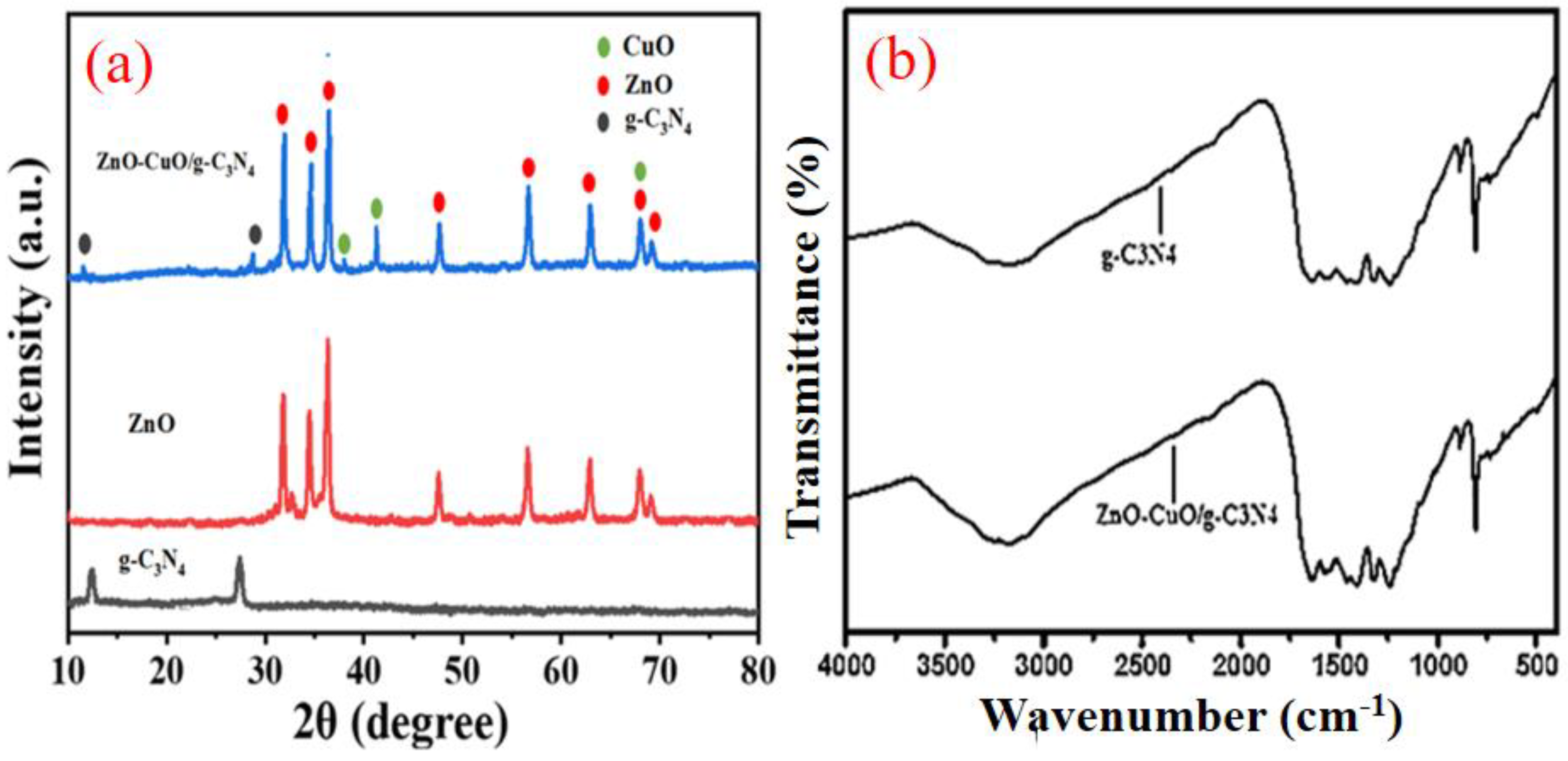


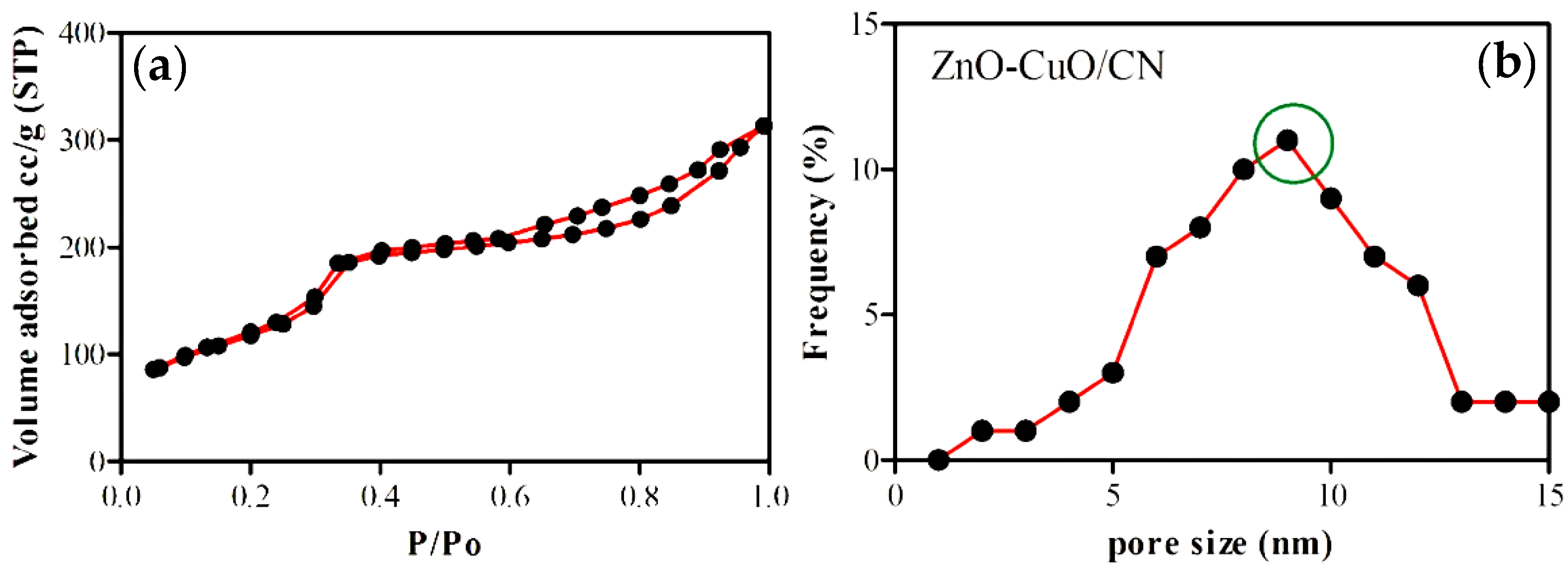
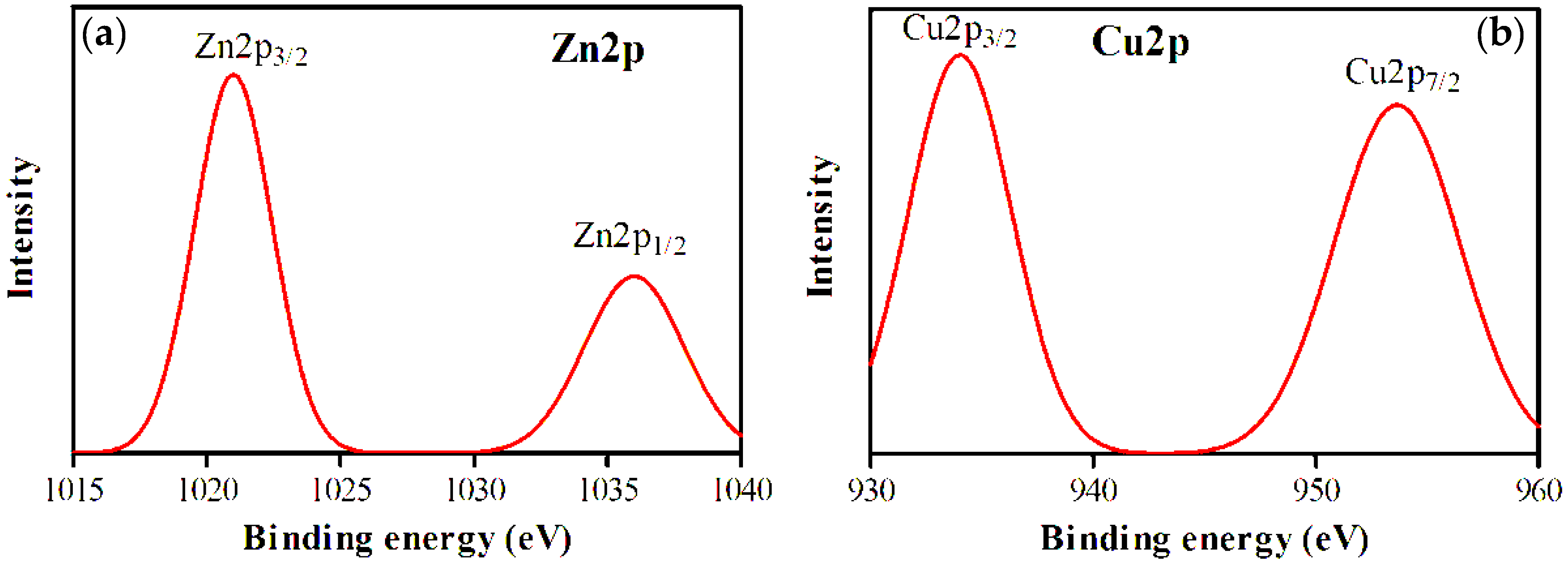
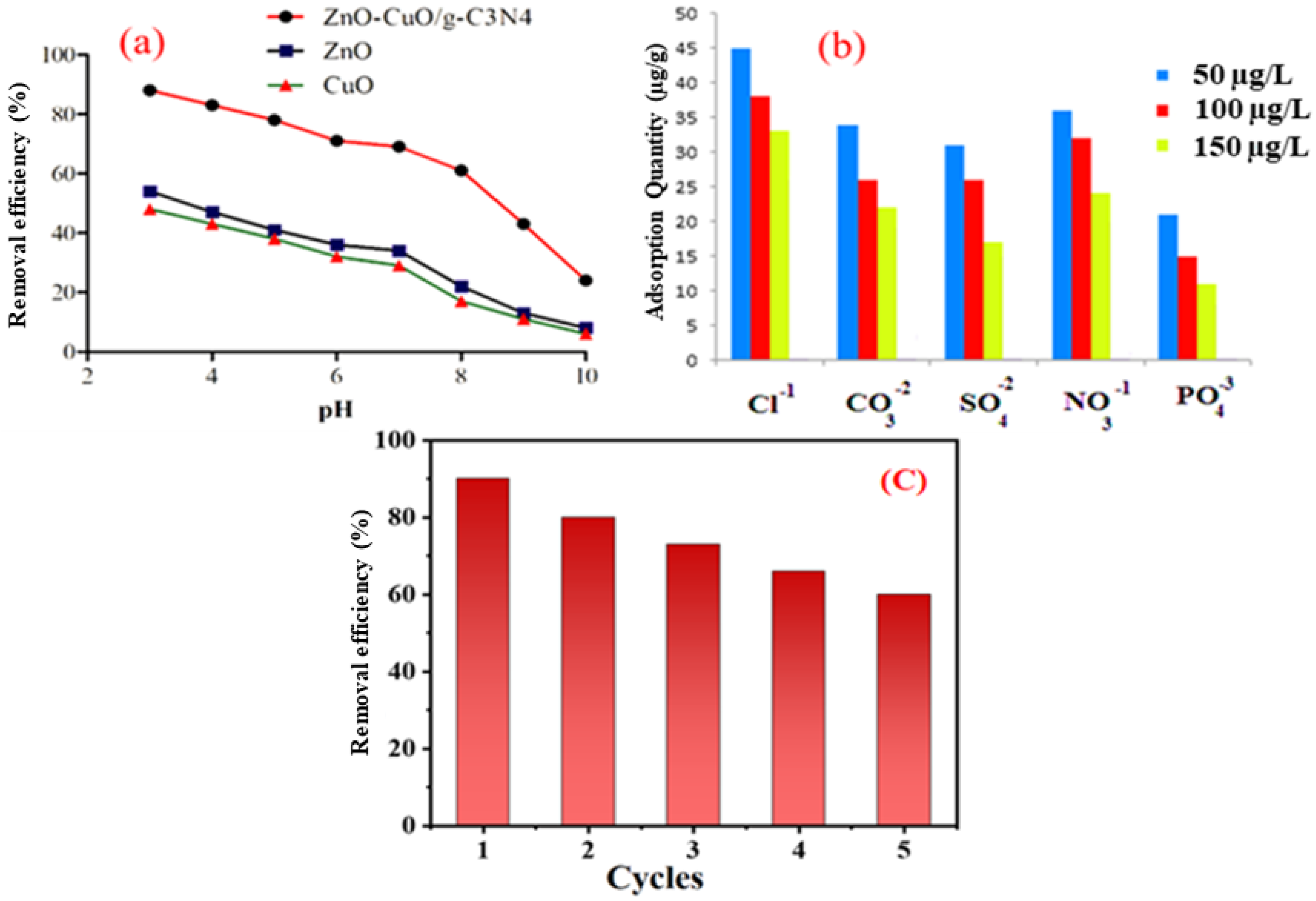
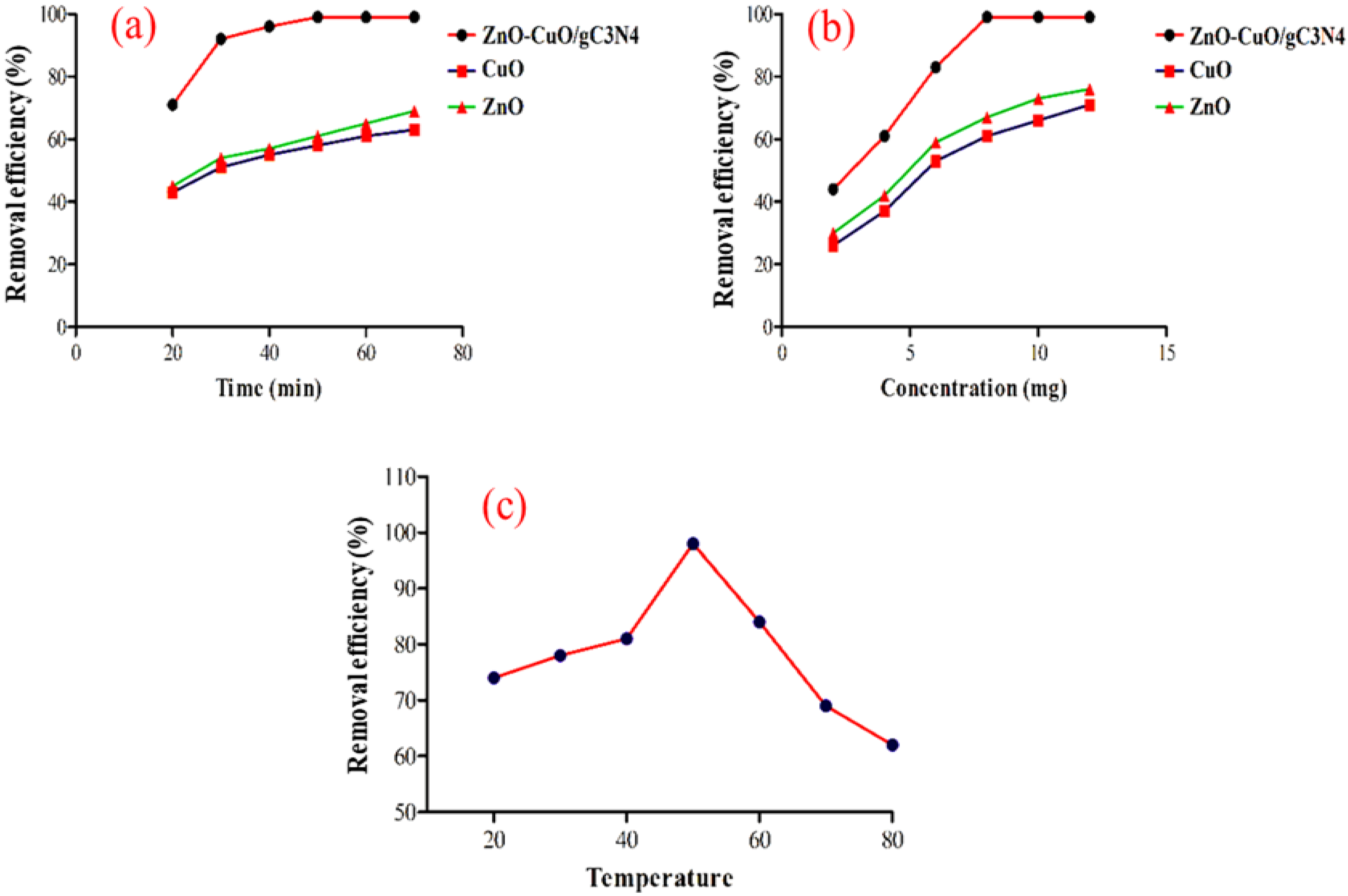
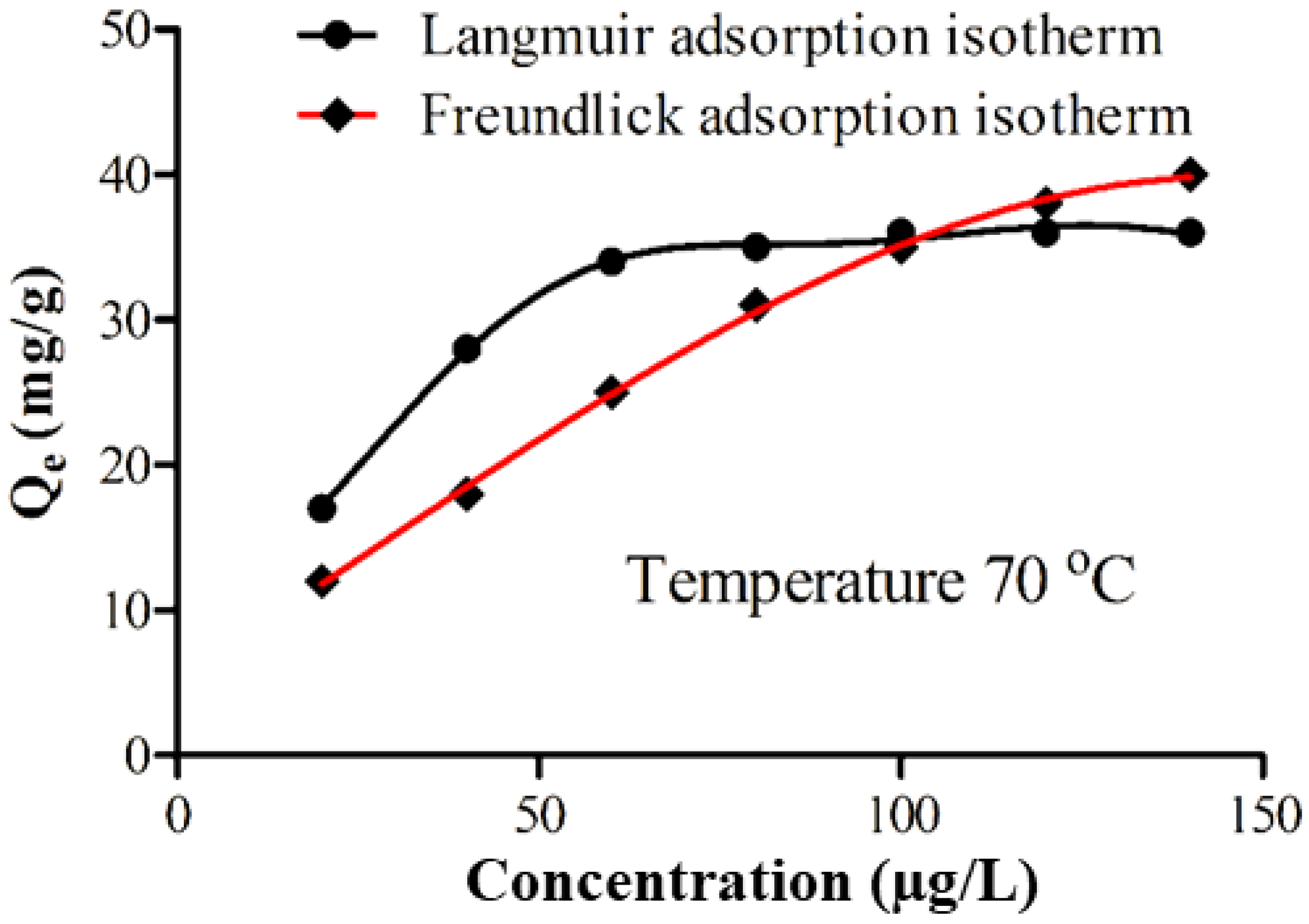
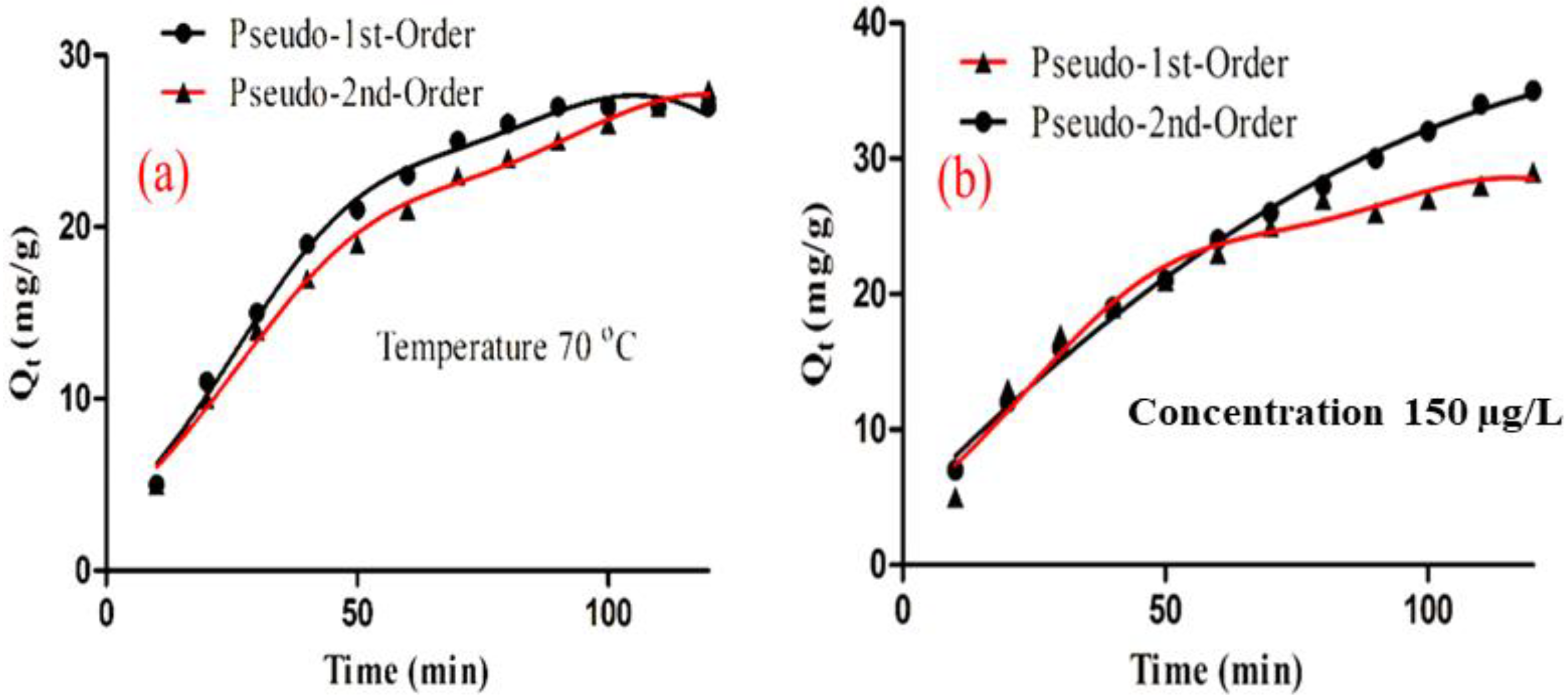
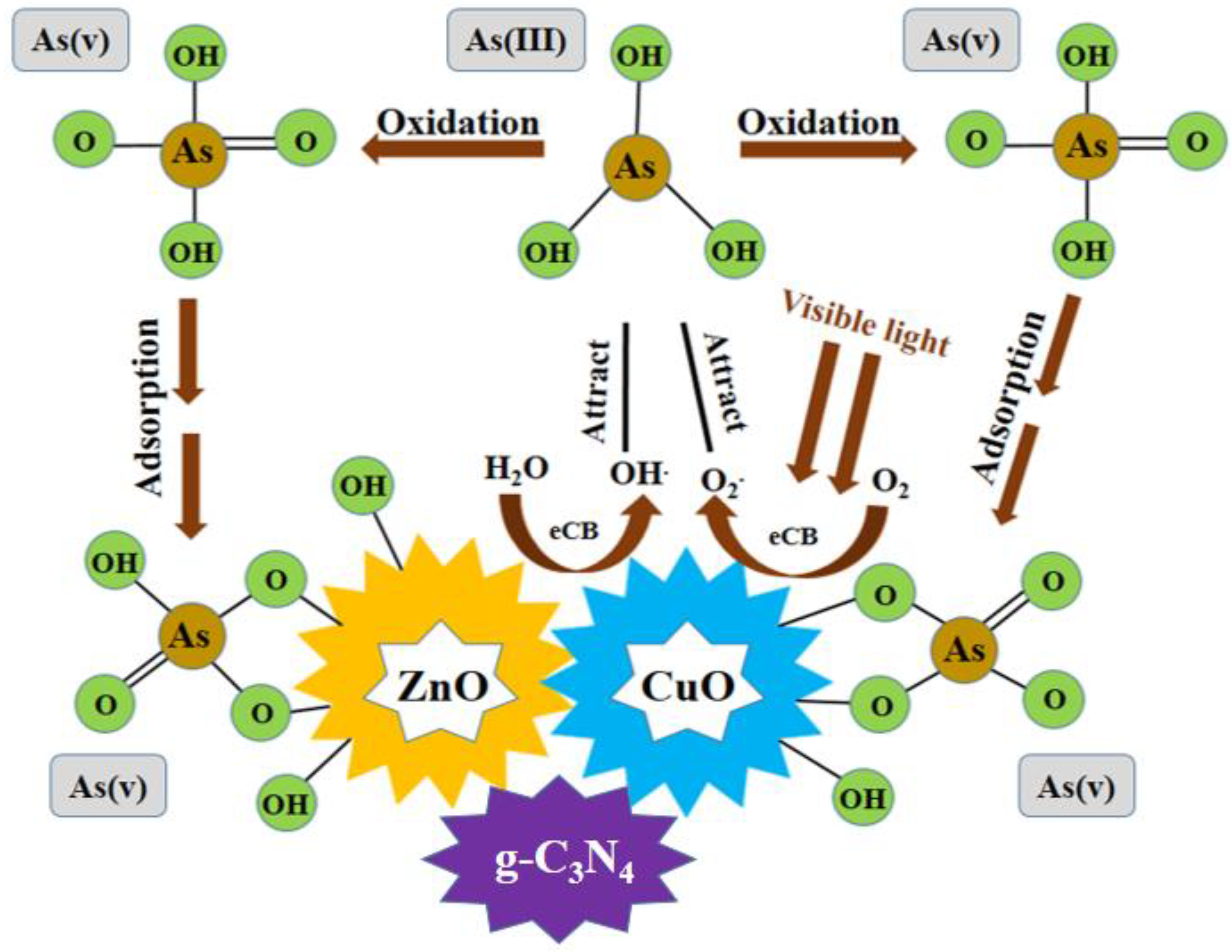
| Adsorbents | Adsorption Capacity | References |
|---|---|---|
| As (mg·g−1) | ||
| Reduced graphene oxide-supported mesoporous Fe2O3/TiO2 nanoparticles | 99.5 | [52] |
| CuFe2O4 foam | 85.4 | [53] |
| Zirconium nanoscale carbon | 110 | [54] |
| (Layered double hydroxides/graphene oxide) nanocomposites | 183.11 | [55] |
| MnFe2O4 | 90 | [56] |
| CoFe2O4 | 74 | [56] |
| GO–MnFe2O4 | 207 | [57] |
| Fe3O4 | 116.56 | [58] |
| Ce–Fe Oxide–carbon nanotubes | 30.96 | [33] |
| Cellulose-based composites | 83 | [59] |
| Copper oxide (II) nanoparticles | 88.3 | [44] |
| ZnO–CuO/g–N3C4 | 97.56 | Current work |
| n | pH | % Removal (Xi) | (Xi − Xavg)2 |
|---|---|---|---|
| 1 | 3 | 98 | 915.06 |
| 2 | 4 | 92 | 588.06 |
| 3 | 5 | 84 | 264.06 |
| 4 | 6 | 73 | 27.56 |
| 5 | 7 | 65 | 7.56 |
| 6 | 8 | 61 | 45.56 |
| 7 | 9 | 43 | 612.56 |
| 8 | 10 | 26 | 1743.06 |
| Xavg = 67.75 | ∑(Xi − Xavg)2 = 4203.48 |
| n | Xi (Arsenic Initial Concentration in ppm) | Xf (Arsenic Final Concentration in ppm) | Di = Xi − Xf | (Di − Davg)2 |
|---|---|---|---|---|
| 1 | 20 | 3.5 | 16.5 | 1054.95 |
| 2 | 40 | 4.7 | 35.3 | 187.14 |
| 3 | 60 | 6.8 | 53.2 | 17.80 |
| 4 | 80 | 14.7 | 65.3 | 266.34 |
| 5 | 100 | 25.4 | 74.6 | 656.38 |
| Davg = 48.98 | ∑(Di − Davg)2 = 2182.6 |
Publisher’s Note: MDPI stays neutral with regard to jurisdictional claims in published maps and institutional affiliations. |
© 2022 by the authors. Licensee MDPI, Basel, Switzerland. This article is an open access article distributed under the terms and conditions of the Creative Commons Attribution (CC BY) license (https://creativecommons.org/licenses/by/4.0/).
Share and Cite
Khan, Q.U.; Begum, N.; Rehman, Z.U.; Khan, A.U.; Tahir, K.; Tag El Din, E.S.M.; Alothman, A.A.; Habila, M.A.; Liu, D.; Bocchetta, P.; et al. Development of Efficient and Recyclable ZnO–CuO/g–C3N4 Nanocomposite for Enhanced Adsorption of Arsenic from Wastewater. Nanomaterials 2022, 12, 3984. https://doi.org/10.3390/nano12223984
Khan QU, Begum N, Rehman ZU, Khan AU, Tahir K, Tag El Din ESM, Alothman AA, Habila MA, Liu D, Bocchetta P, et al. Development of Efficient and Recyclable ZnO–CuO/g–C3N4 Nanocomposite for Enhanced Adsorption of Arsenic from Wastewater. Nanomaterials. 2022; 12(22):3984. https://doi.org/10.3390/nano12223984
Chicago/Turabian StyleKhan, Qudrat Ullah, Nabila Begum, Zia Ur Rehman, Afaq Ullah Khan, Kamran Tahir, El Sayed M. Tag El Din, Asma A. Alothman, Mohamed A. Habila, Dahai Liu, Patrizia Bocchetta, and et al. 2022. "Development of Efficient and Recyclable ZnO–CuO/g–C3N4 Nanocomposite for Enhanced Adsorption of Arsenic from Wastewater" Nanomaterials 12, no. 22: 3984. https://doi.org/10.3390/nano12223984
APA StyleKhan, Q. U., Begum, N., Rehman, Z. U., Khan, A. U., Tahir, K., Tag El Din, E. S. M., Alothman, A. A., Habila, M. A., Liu, D., Bocchetta, P., & Javed, M. S. (2022). Development of Efficient and Recyclable ZnO–CuO/g–C3N4 Nanocomposite for Enhanced Adsorption of Arsenic from Wastewater. Nanomaterials, 12(22), 3984. https://doi.org/10.3390/nano12223984











